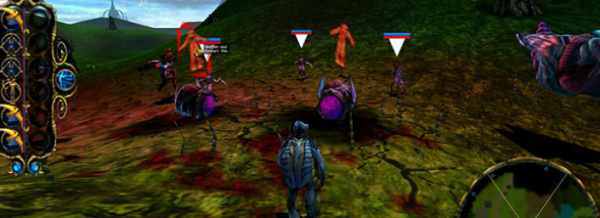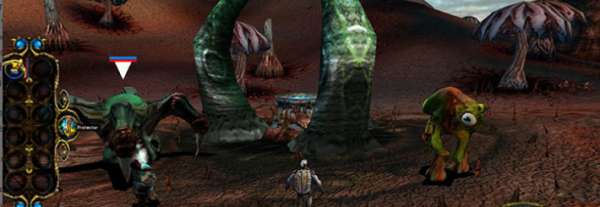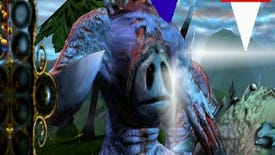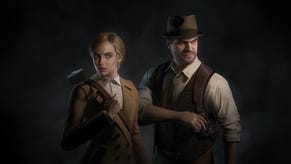Retro: Sacrifice
[With Good Old Games' launch meaning that Sacrifice is once again available to buy, I thought I'd republish this old piece on RPS. A version of it originally appeared in PC Gamer as part of their Long Play series, but it's lived at my blog for a couple of years too. This version has a few tweaks to make more time-appropriate.]
Sacrifice makes me sad.
It’s not that it didn’t get a sequel. It’s not that it didn’t sell at all. It’s not that despite its critical appeal, it’s barely referenced today despite having innovated a number of mechanics and technologies. It’s not that now, years later, Shiny are a laughing stock among gamers’ for the various Matrix misadventures when once they were this good. Hell – it’s not even that due to gamers’ goldfish memories that Shiny’s entire history has been tarnished, with them being Stalinistically revised to always being hopeless.
Sacrifice makes me sad for even bigger reasons.
It's is an action-strategy game, a sub-genre that often received highs-core plaudits only ever found an sizeable audience in its most-militaristic first-person shooter incarnations (Starting with Rainbow Six, in a road that lead to Brothers in Arms et al). Set in a bizarre fantasy world, with five miffed deities waging war against each other, you play a wizard. Not a floppy-hat wizard – but a childhood fever-dream nightmarishly warped wizard.
In the manner directly inspired by eight-bit Spectrum classic Chaos, you’re capable not only of zapping people with thaumatological attacks but summoning followers to war for you. Freshly created, you can order them in an RTS fashion, telling them to go attack distant places, protect things and so on. Its resource-management is built tightly into the skirmish. You war over mana-fonts, which provide the magical energy to power your abilities. The size of your armies is limited to the number of souls you have – your own which can be recycled from the bodies of the fallen or the enemies harvested from his corpses by a soul-doctor spell. It’s not much of a high-level strategy game, more about group tactics and the chaotic melees. Going in with your army arrayed around you, trying to make a difference inside the scrum, summoning the sort of soldiers who’d best take down the opposition…
And playing now, it’s amazing what you’ve forgotten. It’s a game which has kind of found itself in PC Gamer's Top 100 every year through its reputation rather than an active familiarity with it. Last great Shiny game, looked really weird, blah-blah-blah. Except it’s painfully better than that. Take one obvious thing that never gets mentioned among the “Hieronymus Bosch does Command and Conquer”-isms: It’s funny. Really funny. While the similar period Giants gets remembered as being packed full of gags, the brilliantly-voice acted and sharply scripted Sacrifice gets no credit. “Of course I don’t want to destroy the world,” the Death God Charnel argues pointedly, “that’s where all the good slaughters happen”. “Haven’t we all had enough of war?” speaks James, the voice of reason in the heavens. “NO!” ripostes everyone else in perfectly-timed shouted chorus. Away from the world-play, it applies the highest calibre of slapstick. One of James’ highest level spells is an in-gag reference to Earthworm Jim, where the wizard fires a several hundred ton cow into the sky. Thirty seconds or so later it returns, a single target annihilated beneath this beef-missile.
The name of the spell? Bovine Intervention.
Technologically speaking, while it debuted in Messiah, it was the first time where Shiny managed to get their tessellation technology really working, radically scaling the level of detail in the graphics according to the distance. Absolutely standard now, but then an innovation – in fact, so well implemented that while obliviously ageing technology, on full whack is a highly acceptable visual experience.
But it’s the mechanics which throw you. Why do we credit Black & White with pushing its gesture control system when Sacrifice did a subtle, low-key version of it a year earlier? Here the pop-up menus being gradually forgotten about as you discover merely tracing a shape in the air is enough to cause the same effects, seamlessly ordering your followers into defensive positions. It’s an elegant control system, in that it supplements then supersedes rather than merely replacing a more traditional system.
With the mouse-tracing system, the mechanics of “souls” being the game’s economy, being a radical take on RTS-ideas and general timbre of unbridled creativity, the most obvious modern parallel to Sacrifice is Darwinia… and while there’s a mirror in their lack of their deserved commercial success, thinking about Sacrifice makes me sadder than Introversion’s game. Because Darwinia seems like a game with a future – that it’s going somewhere, is a role-model for a whole load of underground creators and another step in Introversion’s plan for whatever the hell it is Introversion want to do.
Sacrifice on the other hand had no future. It was an ending. It was the end of Shiny as a true creative force. It was the end of a certain period of PC games, where a budget to allow real production values was spent on something so self-evidently quirky. In other words, there’s the nagging sensation in the same was as they’ll never be another Nietzsche or Bowie or Amiga Power, we’ll never see its like again. The world which allowed its creation is simply gone forever… and the future that Sacrifice tried to foretell was a more interesting one than the one which we got.
Perversely, as the console-generation clock ticks around, a full eight years after its release it – at its best – feels more next generation than the majority of new games. The maximum level magic powers remain overwhelmingly impressive. A full active volcano erupting beneath you, ground swelling up like a boil of tectonic flesh before cracking open, shooting a hot steam of lava defiantly into the air, all and sundry running. Being snatched up by a whirlwind, spinning around in the ether while still stumblingly trying to control your forces. A towering embodiment of Death, striding the earth and killing indiscriminately. Spiked plants of death lashing out at all and sundry, impaling and lobbing them high into the sky. The bore circling away from its target, etching a spiral into the ground before the very soil itself falls away into the infinite void. We’ve seen things that have aspired to this sort of devastation in classical strategy games, but it’s completely different from the first person. Compared to this poetry of annihilation, a world where a G36 is the height of violence wrought is a little depressing. Seeing glass explode when they could use the same technology to rend mountainsides asunder… put simply, I seen scant things on the X360 that are even a fraction as impressive.
Sacrifice reminds me exactly how good, how imaginative, how brilliant it’s possible for a videogame to be and it’s clear that no-one’s going to spend serious money on making a game like it ever again.
That doesn’t just make me sad. It makes me suicidal.
[Sacrifice is available for $5.99 From Good Old Games]














